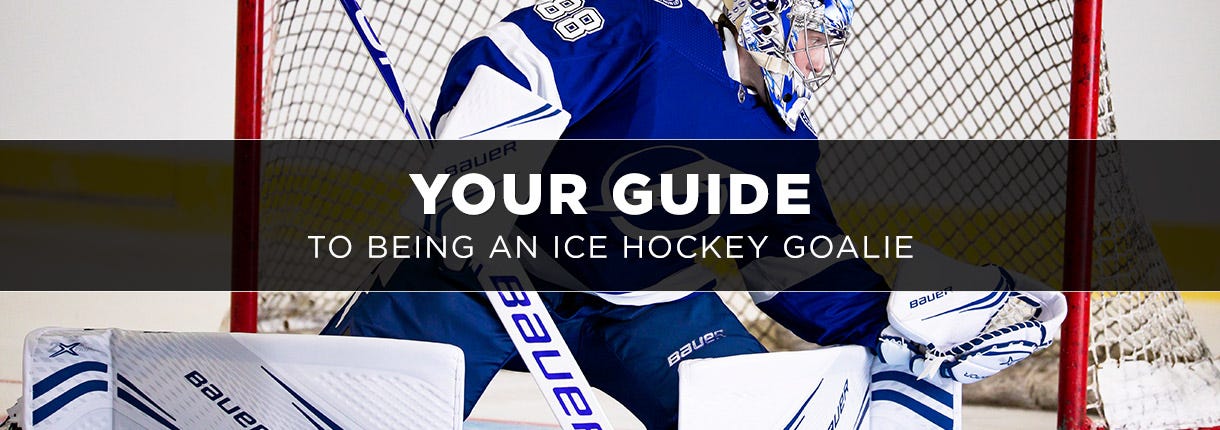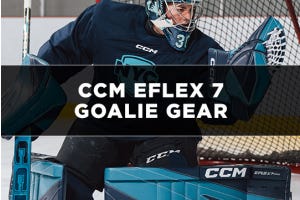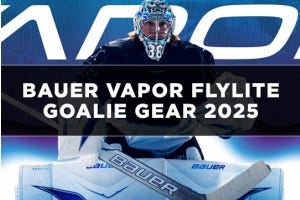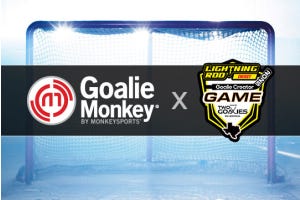Your Guide to Being an Ice Hockey Goalie

As the last line of defense in hockey, a goalie holds the most important position in the game. A goalie can steal a game for a team and one great save or sequence of saves can shift the momentum more than anything else. Having to defend the net and stay protected doing so, there is a lot that goes into the position and learning the basics of movement and gear functionality can be a tough learning curve. With experts who play goalies themselves, we’re here to answer all the questions you might have and GoalieMonkey has all the hockey goalie equipment you need for the game to keep you protected and playing your best.
In this article, we’ll cover:
Basic Hockey Goalie Stance
A goalie’s stance is a critical basis for finding success at the goalie position. Each goalie’s stance will vary slightly to best suit their playing style, ability, and flexibility, but the essence remains the same throughout. The goalie’s stance is designed to maximize coverage in the net while providing the goalie with the best starting point for any of the many movements to make a save.
- Feet: A goalie’s feet should be about a shoulder width’s apart from one another. In a normal goalie stance, the goalie will tend to be leaning forward and utilizing the front half and inside edge of the skate blade.
- Skates: In a traditional stance, skates should be near parallel with ankles having a slight angle inward to provide emphasis on the inside edge of the blade.
- Knees/Hips: The squat and knee bend can be linked to that of beginning to sit in a chair. Knees out forward from the body and about a 90 degree bend at the hips.
- Chest: The goalie’s chest should be upright coming from the hips and square to the puck’s position. While on the feet in the goalie stance, the chest will have a slight face towards the ice to cover more of the net.
- Shoulders: Shoulders should be relaxed and comfortable. Too stiff of shoulders will stiffen the arms and prevent natural, easy movements.
- Blocker: The blocker’s position is quite simple. A good starting point is having the blocker thumb rest on the upper part of the outer roll of the goalie pad. Adjustments can be made from there to best suit the goalie’s comfortability.
- Catch Glove: Catch gloves on the other hand vary considerably from goalie to goalie. There are a wide variety of angles and ways to hold out a goalie glove, however the basic goal is to remain square to the puck at all times. Variances include thumbs up positioning or fingers up positioning with differences in the angle of the elbow being possible as well.
- Stick: With the blocker in position, the goalie stick should naturally angle towards the ice. Goals for stick placement include keeping the blade flat on the ice and about 1 -2 feet in front of the toes of the goalie’s skates. The blade of the stick should naturally have some angle to it to help direct pucks upward and outward from the net and reduce the force of impact on the blade.
A good way to get a feel for maximizing net coverage is having a friend or family member take a picture of a goalie’s stance in net during practice, warmup, or open rink time. Visualize the net coverage and compare your stance to the top NHL goalies’ stances. Adjustments of glove, stick, and leg pad positioning can be made from there.
Hockey Goalie Techniques
Goalie playing styles have evolved greatly since the game has been in existence and even so within the last 20 years. Since the late 1990’s, a new generation of playing style has come to the forefront in the butterfly style. Through the positioning evolving, new gear regulations have forced goalies to adapt and equipment manufacturers to make great advancements in the gear and its ability to protect a goalie. A greater focus on goaltending training and development has led to specific positioning and playing styles for many different situations which are mirrored by the goalies you see today in the NHL.
Traditional / Stand-up Goalie
A traditional or “stand-up” goalie style is going extinct. Goalies of the 70’s, 80’s, and 90’s played the position primarily standing up and would only drop to their knees in the event the play was near the net. Advancements in gear technology and efficiencies in the butterfly style of play make this a very rare style in today’s age.
Butterfly Goalie
The hybrid style of goaltending has evolved in its definition over the past decade. Past and present NHL goalies including Evgeni Nabokov and Jonathan Quick are the definition of this playing style. “Hybrid” style is just that; a combination of butterfly and stand up styles, primarily played as a reactionary style to the shot. Goalies can master this style and be more unpredictable to shooters, however often in playing this position, goalies can find themselves out of position more frequently by having to react to the shot.
Hockey Goalie Positioning & Angles
Like any position in hockey, the approach to a given situation in the game is not always standard. Situations such as a Penalty Kill, Breakaway, or odd-man rush can factor into different approaches a goalie will take to a situation. Even so, in a matter of a split second, a goalie must always be monitoring the current play and both his/hers and opposing players to determine the best positioning and angle for the play. Additionally, goalies playing roller, ball/foot, or another type of hockey often will find different techniques more successful than they would playing ice hockey. Lastly, this may not apply to all ages/groups of goalies. Young players don’t often have the skill or power to shoot or pass the puck like older players do, so a goalie’s positioning will reflect this.
Defensive Depth
A defensive depth is generally used when the goalie identifies a potential cross-ice pass, play near the net, or when his/her team is shorthanded. Playing “deeper” in the net (closer to the net) requires the goalie to cover less distance when moving side to side, thus being quicker and more able to protect the net against a cross-ice pass or play down low.
Base Depth
The base or standard depth a goalie will play is when neither the goalie or the shooter have the advantage. This could be during a typical even-man zone situation or an even-man rush.
Aggressive Depth
An aggressive depth is used typically when the goalie has the advantage over the player and is looking to maximize net coverage and presence. This could be when the goalie identifies a shot from far out or a situation where the opposing player has few options to pass to another player. By playing aggressively and moving further out of the net, the opposing player has less net to shoot at and the goalie has a better ability to cover more of the net.
Hockey Goalie FAQs
What equipment does a hockey goalie need?
A goalie’s equipment setup is designed to protect from head to toe, while allowing for full movement to make saves. This includes Goalie Skates, Leg Pads, Protective pants (breezers), chest and arm protector, blocker, glove, goalie mask, and stick. Besides these items, a variety of accessories are generally worn including, undergarments, neck protector, and groin protector. For a full list and more detailed explanation of a goalie’s equipment, check out our full guide here.
What is the most common hockey goalie playing style?
A hybrid/butterfly style has become the most prominent playing style in hockey today. This style allows for maximum net coverage and an ability to easily move to other areas of the net to make follow-up and rebound saves, depending on the situation.
Is goalie the hardest position to play in hockey?
Goalie is a difficult position, it requires learning to skate and make movements with more gear than skaters, however for many, it comes easier. Often young players will try goalie and become hooked, growing into the position with a background in skating out.
Do you have to be a good skater to play goalie in ice hockey?
It is very helpful for a goalie to be strong on their skates, although they generally don’t have the same speed and agility that skaters do. Being strong on their skates with a good understanding of using both edges is key to the position.











